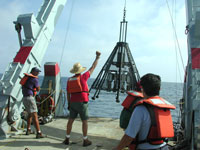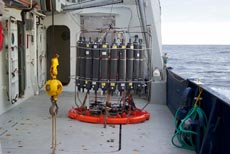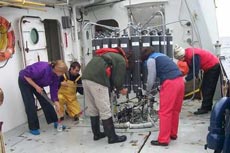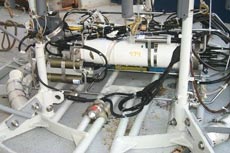


The Project
|
The Project: Research MethodsScientists will work on three major activities during this research expedition. 1. Retrieve the mooring.
The most important activity will be retrieving tools called sediment traps. Sediment traps collect particles sinking down through the water. Each sediment trap is an upward-looking funnel with a ring of “bottles” below the funnel. Every few weeks for the last year, the ring of bottles has rotated under the funnel so that a new bottle can start collecting samples. This mooring, with two sediment traps on it, was anchored in the San Clemente Basin in December 2003. The traps have been collecting settling particles and data on currents and water temperature for the past year. To retrieve the traps, an acoustic signal will cause the mooring to release from its anchor (3 railroad wheels that will remain on the seafloor). Buoyant glass floats on the mooring will cause it to rise to the surface. A radio beacon will allow the scientists to find it. The scientists will bring everything back onboard, piece by piece. 2. Collect sediment samples from the ocean floor.
The "Multicorer" is used to collect sediment samples from the seafloor. It is a steel teepee-shaped frame surrounding a "spider" that holds up to 8 plastic tubes. The multicorer is lowered to the seafloor using the ship’s winch and a hydraulic frame. The impact of the multicorer frame with the bottom will cause the tubes to penetrate about 50cm into the sediments. When the winch starts to pull the multicorer back up, shovel-like arms close under the tubes and prevent the sediments from falling out during the trip back to the ship. Once the multicorer is back on deck, the scientists will cap the tubes and process them for storage in the refrigerated van located on the main deck. The van will be kept at a chilly 4ºC--the approximate temperature at the seafloor. Storing the cores at this temperature helps prevent any chemical changes which would change the composition of the sediments.
Multicorer animation 3. Collect water samplesThe scientists will collect ocean water samples by using a CTD-rosette. This is an instrument that reads the electrical Conductivity (related to salinity) and Temperature with Depth in the water (calculated from pressure). As the instrument is lowered through the water column, this information is sent from the CTD-rosette back to a computer in the lab on the main deck. This allows the scientists to see these water properties in "real-time". The frame housing the CTD also holds a ring (rosette) of "Niskin" water sampling bottles. As the instrument passes through the water, individual bottles can be "closed" by computer, capturing a seawater sample from any specific depth. Once on deck, samples from the Niskin bottles are transferred into clean bottles for transport and chemical analysis for dissolved elements (including Barium) back in Corvallis.
top left: CTD Other pages in this section:
|






